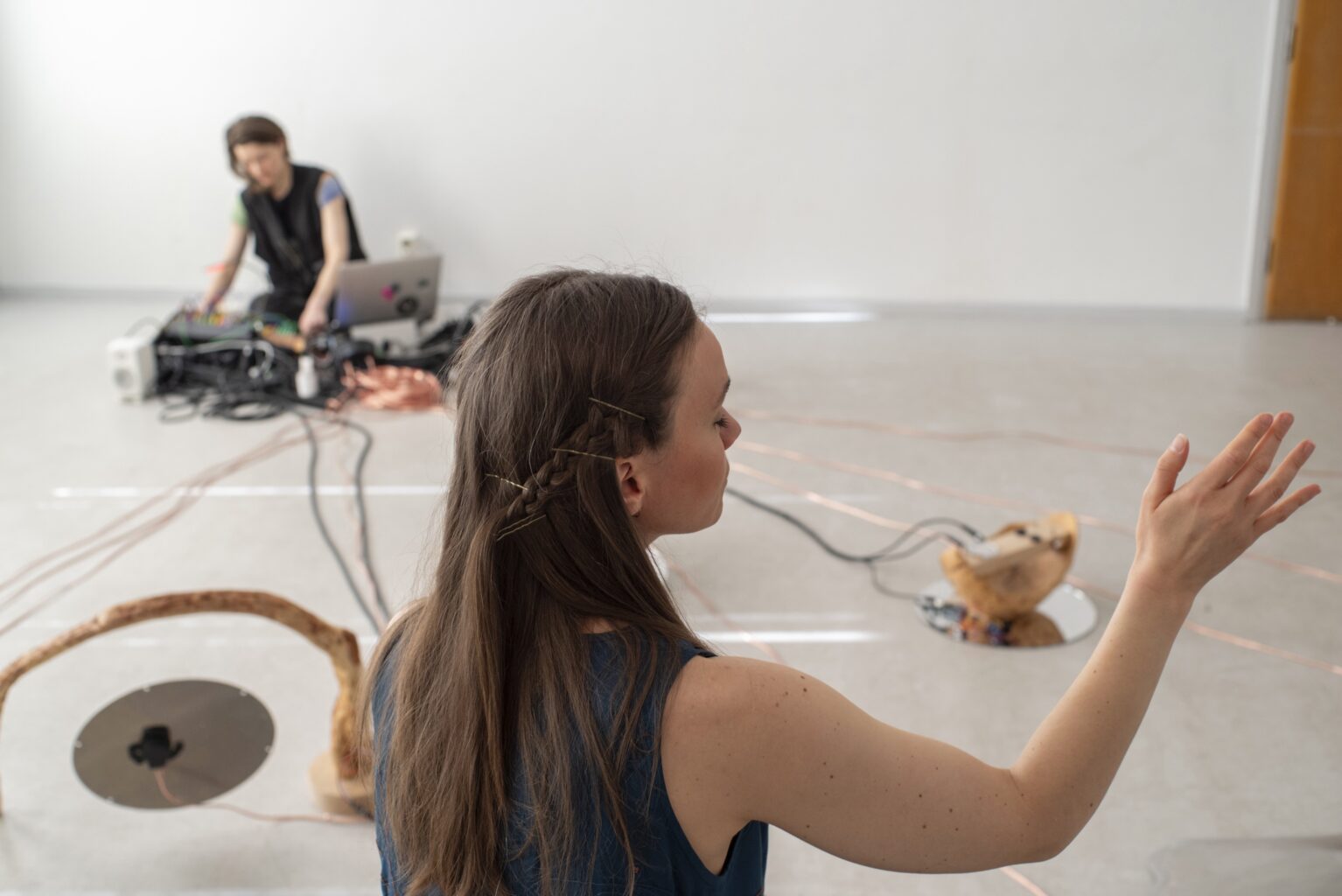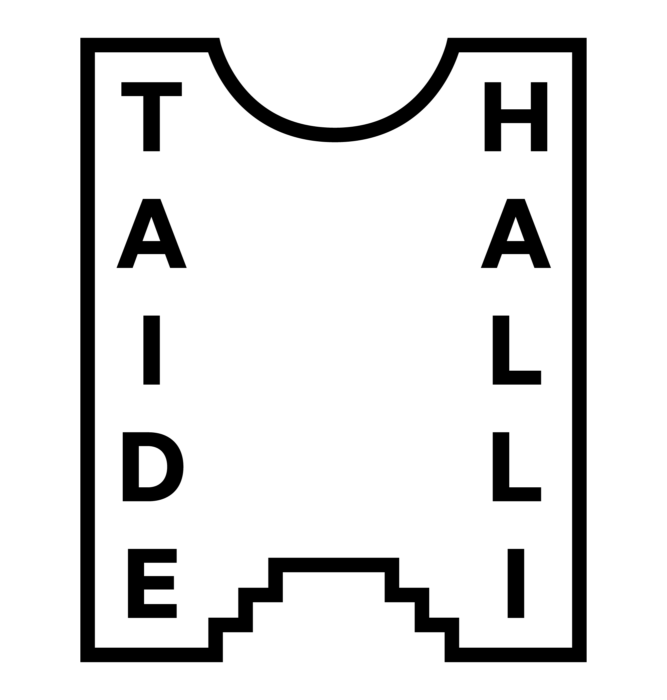
What was the starting point of Maze? Could you share some insights into your research and working process?
Also, could you tell us about your long-term collaboration with Julia Giertz and how it has influenced your body of work?
Marie: To define a starting point for Maze already says something about the work itself. Maze is an entanglement of questions and issues that have arisen from both our artistic practice and our private lives.
A maze has many possible entrances and exits, unlike a labyrinth. The concept of the maze is present in many layers of this work: form, process, and audience experience. If you follow the many threads that have shaped this project, they form a maze in themselves. Out of the eight performances we have created together, Maze is the only work where we both perform in the space, also the only work that continues to develop and change. It is a work that adapts to our expanded interests and changing life conditions—a work we hope to keep performing throughout our entire life cycle.
Here, I’ll try to share some of the most important starting points: Understanding time. Maze is part of what is, up until now, a trilogy on time. Besides Maze, the trilogy includes The Labyrinth (2022) and True Random (2025). All three works deal with the movements between past, present, and future. The Labyrinth (2022) evolved from thinking about time in relation to birth. Maze (2023) evolved from thinking about time in relation to life cycles and how every brief moment also contains eternity. True Random (2025) evolves from thinking about time in relation to endings or death.
From the beginning, the idea was to create three choreographies with three distinct movements: moving forward, moving in cycles, and moving backwards. I remember very clearly the moment when this idea was born. It was during the Covid pandemic. I had just had my second child and was waiting in the hour-long lines at a test centre in a public park in Copenhagen, while talking on the phone with Julia, who is based in Stockholm. The scene—white tents, medical personnel, and hundreds of citizens waiting to be tested—truly evoked the sensation of time standing still while at the same time moving faster than imagination.
Another starting point was the philosophy of the Swedish philosopher Jonna Bornemark. In her book Jag är himmel och hav (2022) (I am Sky and Sea), she writes: “The pregnant woman controls her body and at the same time does not; she is passive and active at once, she encounters both life and death. She is one—and at the same time two. It is an experience that has not been given space within philosophy; the Western philosopher has typically not been a woman, let alone a pregnant woman.”
She asks: “If we were to take this experience seriously, what would we then discover? Where would it lead us?”
Her thinking inspired us to consider how one can be both an individual and an environment at the same time—the kind of presence this produces. We became interested in creating a performing presence that did not dominate the space but instead interacted softly with the installation, allowing the audience to drift between objects, sounds, and human presence.
Another important starting point was our collaboration. Julia and I have been working together for many years. We both graduated as dancers from the Danish National School of Performing Arts in 2009 and are close friends. In the years that followed, Julia began making music and I focused on choreography. Instead of forming a collective or a duo, we decided that for each project we would define who was the artistic owner. Sometimes it’s me, sometimes it’s a collaboration, and sometimes it’s Julia’s project. This clarity in artistic ownership has given us freedom and joy in the collaboration and has freed us from some of the burdens that can come with running a company together.
When we started creating Maze, we had worked together for about 10 years and had created six black box performances. We had developed a method, and it was clear that it was time to challenge both our practices and the expectations of our audience. We had a distinct artistic language and a sense of stability or “safety” in our common practice, but we needed to destabilize that in order to continue developing together. We knew we needed to create new conditions to work more deeply. From the beginning, we had a clear desire for Maze to be experienced as much as a sound installation as a performance. Neither of our individual practices should dominate the work—and that is a balance we continue to adjust.
Marie, we see you rooted with both feet into the ground, with movements happening only in the upper part of your body, including your gaze–oracle like–I am curious about your sensation of the passing of time in Maze?
Julia, could you also answer this question from your perspective, being on stage and in direct communication through music/sound with Marie?
Marie: The experience of time while performing Maze is almost hallucinatory. I work with a practice of renewal. I move between the eyes of the spectators, and every time I meet someone’s gaze, I try to ground myself in that encounter, into their eyes—not staring, but grounding—while also grounding my feet into the floor, into the earth. Then I drift with the person. Sometimes I try to read their thoughts, sometimes I induce emotions. I work intensely with my imagination, traveling in my mind. I listen to Julia with my ears, but to the audience with my eyes.
The dance or practice of Maze has no chronological time. Every time I shift to a new person, it is a reboot of the situation. Over the course of the two-hour duration, I lose track of time; I can’t separate one performance from another—I only remember the encounters. When I sit there, I feel as though I’ve been sitting there for a hundred years.
The oracle is an archetype I keep returning to. To enter the performance space as an embodied portal that can potentially open the imagination and inner emotional landscape of the spectator is an approach to performance that I find deeply interesting.
Julia: Since I follow a score, my position in Maze is that of the timekeeper. I create the cycle that repeats, and at the same time I follow that repetition. In Maze I am both the generator and the receiver of sound. The same sound source will sound very different depending on the material I send it to. Since I also listen to the instrument’s responses, I hear both past and present versions of the gestures I am making.
In that sense, I experience myself as both the guardian of the chronological layer of Maze and as part of its architecture: I contribute to its evolving repetitions, echoes, and folds.
Marie and Julia, I would be curious to hear from both of you how you related to and defined the title of this work?
As mentioned, Maze is part of a series of three works—The Labyrinth, Maze, and True Random. All of these titles are metaphors for life or the passing of time, the most fundamental movement.
A labyrinth has a single, continuous path that winds and curves, leading directly to the centre (or out, in some cases), without any choices or dead ends. A maze, on the other hand, typically has multiple paths, dead ends, and branching routes, requiring the solver to make choices and find their way through a complex network to reach an exit.
In The Labyrinth we explored the sensation of time moving forward, accelerating along a path—as if there were a map to follow—as well as the idea of acceleration itself (a sensation of lack, of never arriving).
While creating Maze, we both had small children and had also experienced the heavy losses of close family members. Time became very circular, revolving around a few daily gestures—comforting, holding, embracing. Life and creation were deeply entangled. The confrontation with parenthood, with aging and the effort to combine it with our artistic practice infiltrated both the process and the work itself. As co-workers with a feminist practice, we had to redefine how we could work deeply together. Looking back, we can now see some beauty in it, but at the time it was messy. Often it felt like we lost the overview of our process—much like when you enter a maze.
Maze started as a working title that felt precise for the choreographic vision and the more formal aspects of the work. In the beginning we were sure we would change it, but as we moved further into the process, we connected to it more emotionally. The title began to describe not only the work but also our lives and the artistic process we were, and still are, navigating together.
Julia Giertz & Marie Topp: Maze
Kunsthalle Helsinki 8.11.2025 10.00 / 9.11.2025 10.00
Soup Talk 9.11.2025 13.00 @Caisa
Music and electronics: Julia Giertz
Choreography and performance: Marie Topp
Dramaturgy and text: Igor Dobričić
Programmer PD and Bela: John Chantler
Programmer Arduino: William Rickman
Metal resonators : Samuel Norup
String instruments: Julia Giertz and Felix Ahlberg Ericsson
Costume Designer: Maria Ipsen
Producer: Carlos Calvo
Graphic Design: Evelina Mohei
Production: Visible Effects
Co-production: Milvus Artistic Research Center
Residency: Milvus Artistic Research Center supported by Nordic-Baltic Mobility Programme/Nordic Culture Point. Hägerstens Medborgerhus
Supported by: Statens Kunstfond, Knud Højgaards Fond, William Demant Fonden, Københavns Kommune
Maze premiered at MARC, Knislinge, Sweden, in October 2023.
Photo: S. Marcus Jablonski and Santiago Mostyn
Visit supported by: Danish Arts Foundation
Visit in collaboration: Kunsthalle Helsinki

